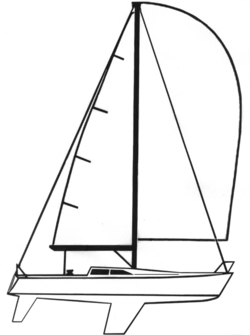
Olson 30
Encyclopedia

 |
Introduction
The Olson 30 is a sailboatSailboat
A sailboat or sailing boat is a boat propelled partly or entirely by sails. The term covers a variety of boats, larger than small vessels such as sailboards and smaller than sailing ships, but distinctions in the size are not strictly defined and what constitutes a sailing ship, sailboat, or a...
designed by George Olson of Santa Cruz, CA around 1978. Olson was a surfer and surfboard shaper who decided to design a 30' ultra light displacement boat while on a delivery from Honolulu to Santa Cruz on Merlin, a 68' Bill Lee designed and built http://wizardyachts.com/blboats/blboats.html ultralight sailboat which had competed in the biennial Transpac
Transpacific Yacht Race
The Transpacific Yacht Race is an offshore yacht race starting off Point Fermin, San Pedro, near Los Angeles, and ending off Diamond Head Lighthouse in Honolulu, a distance of around . Started in 1906, it is one of yachting's premier offshore races and attracts entrants from all over the world...
race in 1977. During this delivery, Olson came up with the idea while sailing with Denis Bassano and Don Snyder, who lent their initials to the prototype's name, SOB 30. The resulting boat was christened Pacific High, and it was launched in 1978.
As a result of what Olson learned about the sailing characteristics of Pacific High, he constructed a plug for a production boat. The draft was reduced somewhat, the freeboard was increased, and the teak decks of the prototype were replaced with fiberglass and rolled-on non-skid. Olson and partner Lyn Neale started Pacific Boats in an industrial area of Live Oak, CA
Live Oak, Santa Cruz County, California
Live Oak is a census-designated place in Santa Cruz County, California between the towns of Santa Cruz and Capitola. Live Oak sits at an elevation of...
, an unincorporated area between Santa Cruz and Capitola.
The Olson 30 was introduced into a crowded market of ultralight boats constructed in the Santa Cruz area, including Ron Moore's Moore 24
Moore 24
The Moore 24 is a type of sailboat.Designed by Santa Cruz, California surfer/sailor, George Olson, it is one of the first ultralight displacement sailboats, or ULDBs entering production in 1972. This design, along with the Santa Cruz 27 and Olson 30 changed the world of performance sailing with...
and Bill Lee's Santa Cruz 27. The Olson 30 featured a single spreader masthead sloop rig with aluminum spars from either Sparcraft Spars http://www.sparcraft.com/ or Ballenger Spars http://www.ballengerspars.com/ of Santa Cruz. Unlike the Moore 24 and Santa Cruz 27, the Olson 30 was relatively beamier and was not legally trailerable without a special permit in California (although it's unclear whether any of the owners actually sought out permits). Construction was similar to the other Santa Cruz boats with polyester resin, E-glass, and an end-grain balsa core in the hull and deck. The keel was cast lead with a small "stubby" of fiberglass, and the rudder was a fiberglass and foam sandwich with a pultruded fiberglass shaft. Unlike many of the boats built in Santa Cruz, the Olson 30 had a light spruce plywood interior, in contrast to the more common Bruynzeel
Kees Bruynzeel
Cornelis Bruynzeel was a Dutch businessman, timber merchant and yachtsman.-Early years:Bruynzeel was the son of Cornelis Bruynzeel Sr., who founded a timber factory in 1897, and Antoinette Lels. He studied in The Hague, and took several trips to the United States and Sweden to study progress in...
plywood interiors of other boats.
Approximately 250 boats were built by Pacific Boats and Ericson Yachts
Ericson Yachts
Ericson Yachts, Inc. was a pioneering builder of fiberglass yachts. Ericson is now out of business, but its designs have been reproduced periodically by other manufacturers.-History:...
. You can find out more about specific boats by researching the Olson 30 Hull Number Database http://www.olson30.org/theboat.html.
Racing History
The Olson 30 races as a MORC (Midget Ocean Racing Class) handicapped competitor, as well as a PHRFPHRF
Performance Handicap Racing Fleet is a handicapping system used for yacht racing in North America. It allows dissimilar classes of sailboats to be raced against each other...
(Performance Handicap Rating Fleet) and One Design
One-design
One-Design is a racing method where all vehicles or boats have identical or very similar designs or models. It is also known as Spec series. It is heavily used in sailboat racing. All competitors in a race are then judged based on a single start time...
competitor. As a demonstration of the boat's seaworthiness, various Olson 30s have sailed in races from Southern California to Mexico, across the Atlantic, and numerous trips from California to Hawaii. In 1980, 1982, and 1984, Olson 30s competed in the Singlehanded Transpac, a biennial race from San Francisco to Hanalei Bay, Kauai, Hawaii. A combination of their relative low cost, speed, and strength has made them a favorite of singlehanded racers on the Pacific Coast.
On the East Coast, an Olson 30 has appeared at least twice in the biennial Bermuda 1-2 race (http://www.bermuda1-2.org/)
Racing Organizations
The Olson 30 National Class Association http://www.olson30.org/ presides over the set of rules that regulate racing an Olson 30 as a One Design class, and it provides support for a yearly National Championship regatta. Past Nationals have been held most commonly in Long Beach, CA, San Francisco CA, Lake Tahoe, CA, or Seattle, WA, but have been held in other locales from time-to-time. In addition to the national class association, several regional class associations exist where the boat is popular enough to support a regular one-design fleet. There are established fleets in the Pacific Northwest http://www.olson30.org/regional/pnw/index.shtml, San Francisco http://www.olson30.org/regional/sanfrancisco/index.html, and Los Angeles http://www.olson30.org/regional/socal/index.html areas, as well as representation on the Great Lakes http://www.olson30.org/regional/greatlakes/, on the United States East Coast, Hawaii, and in the Caribbean.Where boats do not race in One Design starts, the boat competes using the well-known PHRF handicapping system, and more recently in some cases the Americap system. Using these handicapping systems, the Olson 30 is commonly pitted against other well-known racing designs such as the Melges 24
Melges 24
The Melges 24 is a one-design class of sailboat commonly used for racing. The boat is notable for its ability to plane over the water downwind in modest winds, and for its combination of a simple design that is highly tunable....
Melges 24
Melges 24
The Melges 24 is a one-design class of sailboat commonly used for racing. The boat is notable for its ability to plane over the water downwind in modest winds, and for its combination of a simple design that is highly tunable....
, Soverel 33
Soverel 33
The Soverel 33 is a high performance racing yacht, launched in 1983 by renowned racing sailor and designer Mark Soverel. It was primarily intended as a one-design fleet but, although approximately 90 boats were built, that never quite happened...
Soverel 33
Soverel 33
The Soverel 33 is a high performance racing yacht, launched in 1983 by renowned racing sailor and designer Mark Soverel. It was primarily intended as a one-design fleet but, although approximately 90 boats were built, that never quite happened...
, and J/29.
General Sailing Performance
Because the Olson 30 is so light for its length and has a relatively overpowered (for its design's age) sail profile, the Olson 30 excels at light-air sailing. In moderate conditions the sailing performance is unremarkable. In heavy conditions upwind the Olson 30 suffers from the lack of weight to drive the bow and the boat through waves, however downwind in a breeze the Olson 30 surfs and planes readily, and it was for these conditions the boat was ultimately designed. The stock rudder tends to be underpowered in heavy air, leading to difficult driving downwind especially in short waves and big wind.Modifications
As a production recreational sailboat the Olson 30 has been very resilient over time, and one can still find non-racing Olson 30 sailboats actively sailing today in exactly the same configuration as they were shipped in from the factory more than 20 years ago.However as a One Design sailboat racing class, the Olson 30 has always been an experimental class. It lacks the extremely rigid One Design class rules that limit sail purchases, sail and boat materials, and some types of modifications. As a result many racing Olson 30s, in an effort to tweak performance and increase the longevity of an already very resilient boat, have had minor-to-extensive work done to maximize the performance of the boat within the class rules.
Many boats have been upgraded to a Ballenger double-spreader rig, frequently using the original spar and a retrofit kit that includes new shrouds and two pairs of spreaders. This stabilizes the otherwise flexible rig. Several Seattle owners, who owned boats with Ballenger or Sparcraft single-spreader masts, pioneered a technique to move the single-spreader rig's existing capshroud terminals to the very top of the mast by elongating the spreaders and cutting longer capshrouds http://www.olson30.org/regional/pnw/howto/spreaderconversion.html.
Due to some challenges of steering the boat downwind in a blow, some boats were fitted with elliptical rudders to improve handling. These rudders were typically fabricated by Moore.
While One Design racing class rules specifically prohibit reinforcing the hull with longitudinal stringers or added bulkheads, many other kinds of modifications exist to increase hull rigidity. These can include a rigid beam between the chainplates http://www.olson30.org/BeamofDestinyJockstrapsNew.html, rod rigging run from under the base of the keel-stepped mast to the chainplates, and so on. Recently the class rules were amended to allow some very limited reinforcement of the area between the forward bulkhead and cabinets.
A few boats had inboards installed, although this is uncommon.

